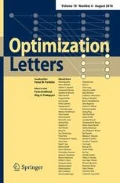Abstract
We consider a new dynamic edge covering and scheduling problem that focuses on assigning resources to nodes in a network to minimize the amount of time required to process all edges in it. Resources need to be co-located at the endpoints of an edge for it to be processed and, therefore, this problem contains both edge covering and scheduling decisions. These new problems have motivating applications in traffic systems and military intelligence operations. We provide complexity results for the dynamic edge covering and scheduling problem over different types of networks. We then show that existing approximation algorithms for parallel machine scheduling problems can be leveraged to provide approximation algorithms for this new class of problems over certain types of networks.
Similar content being viewed by others
References
Asahiro, Y., Hassin, R., Iwama, K.: Complexity of finding dense subgraphs. Discret. Appl. Math. 121, 15–26 (2002)
Asahiro, Y., Iwama, K., Tamaki, H., Tokuyama, T.: Greedily finding a dense subgraph. J. Algorithms 34, 203–221 (2000)
Chen, A., Chootinan, P., Pravinvongvuth, S.: Multiobjective model for locating automatic vehicle identification readers. Transp. Res. Record J. Transp. Res. Board 49–58, 2004 (1886)
Coffman, E.G., Garey, M.R., Johnson, D.S.: An application of bin-packing to multiprocessor scheduling. SIAM J. Comput. 7, 1–17 (1978)
Feige, U., Korstsarz, G., Peleg, D.: The dense \(k\)-subgraph problem. Algorithmica 29, 410–421 (2001)
Feige, U., Langberg, M.: Approximation algorithms for maximization problems arising in graph partioning. J. Algorithms 41, 174–211 (2001)
Friesen, D.K.: Tighter bounds for the MULTIFIT processor scheduling algorithm. SIAM J. Comput. 13, 170–181 (1984)
Garey, M.R., Johnson, D.S.: Computers and intractability. W.H. Freeman and Company, New York (1979)
Graham, R.L.: Bounds on multiprocessing timing anomalies. SIAM J. Appl. Math. 17, 263–269 (1969)
Khot, S.: Ruling out PTAS for graph min-bisection, dense \(k\)-subgraph, and bipartite clique. SIAM J. Comput. 36, 1025–1071 (2006)
Pinedo, M.L.: Scheduling: Theory, Algorithms, and Systems, 4th edn. Springer, New York (2012)
Roupin, F., Billionnet, A.: A deterministic approximation algorithm for the densest \(k\)-subgraph problem. Int. J. Oper. Res. 3, 301–314 (2008)
Sherali, H.D., Desai, J., Rakha, H.: A discrete optimization approach for locating Automatic Vehicle Identification readers for the provision of roadway travel times. Transp. Res. Part B: Methodol. 40, 857–871 (2006)
Author information
Authors and Affiliations
Corresponding author
Rights and permissions
About this article
Cite this article
Qiu, J., Sharkey, T.C. A dynamic edge covering and scheduling problem: complexity results and approximation algorithms. Optim Lett 8, 1201–1212 (2014). https://doi.org/10.1007/s11590-013-0658-x
Received:
Accepted:
Published:
Issue Date:
DOI: https://doi.org/10.1007/s11590-013-0658-x




